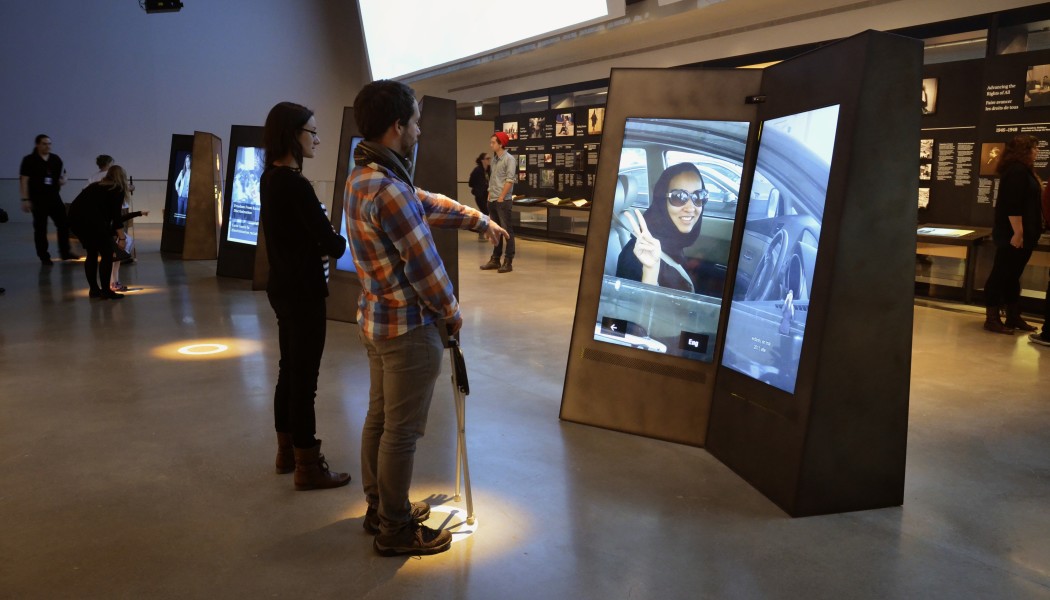Winnipeg’s striking new Canadian Museum for Human Rights explores the universal concept of human rights with a special emphasis on Canada. Electrosonic was contracted to do the audio-visual design for the museum’s eleven galleries, and subsequently the company directed the AV equipment installation working with local partner Advance Pro. The museum features theatres, interactive touchscreen stations, projections on a digital canvas and hundreds of video clips.
Eleven media partners were involved in the build-out requiring considerable technical coordination by Electrosonic. The company worked closely with SH Acoustics, LLC of Milford, Connecticut, on the museum’s audio elements.
The project posed a number of challenges due to the building’s unique architectural profile, which was designed by US architect Antoine Predock, working with Winnipeg’s Architecture 49. Designed to move visitors onward and upward through space, the museum includes alabaster ramps and stone-clad bridges crisscrossing a 170-foot atrium.
“This is not a museum with typical box-like galleries,” says Steve Haas, president and principal consultant at SH Acoustics. “There isn’t a single right-angle wall, and there are triangulated gaps two-to-three feet wide at their largest point. Standing on the first floor you can see exhibits on the fifth floor, so in developing audio strategies and acoustic treatments, we had to keep in mind the ferocity of the building.”
Theatres are scattered throughout the museum. The first one visitors encounter is in the gallery defining human rights. The open-air theatre format, with bench seating, features a three-projector edge blend on scrim; sculptures behind the scrim form part of the story. Three Barco HDX-W20 FLEX projectors are ceiling mounted; a Dataton WATCHOUT system handles edge blending.
The Indigenous Perspectives gallery has a 360º theatre where visitors watch a video about First Nations’ concepts of rights and responsibilities to each other and the land. It’s outfitted with six Barco CNWU-61B projectors, with a seventh projector available for special presentations. Another WATCHOUT system performs the edge blend.
The gallery devoted to Canadian Journeys has a single-projector theatre with a Barco CNWU-61B unit plus a two-story Digital Canvas featuring two walls of screen prints and a third wall of imagery displayed by four Panasonic PT-DS20KU projectors.
Another gallery, with a short-throw projector, delivers content about protecting rights in Canada. A single-screen theatre in the Examining the Holocaust gallery, with a Barco CNWU-61B projector, has walls comprised of plate glass shards symbolising the Nazi’s infamous Kristallnacht. A second theatre, presenting a film that marks the Ukrainian Holodomor famine-genocide, has a similar setup. Four projectors combine to display an elevated 80-foot projection-wall backdrop in the gallery.
A media installation in the Rights Today gallery features three Barco CNWU-61Bs projecting onto the wall surface; edge blending is performed by a tvONE system.
Numerous AV displays and interactive stations, many of them 27-inch ELO touchscreens, deliver content and engage visitors as they make their way through the galleries. To ensure that all museum guests have full access to the interactives, Electrosonic collaborated closely with the museum team to build custom Universal Key Pads easily reachable by people with disabilities.
Fifteen AV niches are featured in Canadian Journeys; the displays have, in various configurations, embedded Samsung and NEC monitors, and Viewsonic and Barco projectors. Protecting Rights in Canada has a 15-station interactive “Debate Circle” game played on ELO touchscreens; players’ scores are shown on a trio of 65-inch Samsung monitors.
The gallery exploring the Universal Declaration of Human Rights has four interactive stations, each with two portrait-mounted 55-inch Samsung monitors and Microsoft Kinect gesture recognition technology. A digital study table is comprised of 12 MultiTouch 55-inch touchscreens mounted face up, side-by-side; it is operated via Tactable software. A Media Literacy Theatre has two 75-inch Samsung monitors hung in portrait mode one on top of the other.
Actions Count, a gallery targeted to young visitors, has a gesture-recognition game, too. This one features three Barco CNWU-61B projectors shooting down onto three tables.
Steve Haas has worked on dozens of projects with Electrosonic that have spanned some 25 years, including the United States Holocaust Memorial Museum and the Newseum in Washington, DC. His typical approach to managing sound in media-intensive environments is to provide focused zones of sound for several people viewing exhibits and larger zones of sound spread throughout galleries – always making sure not to distract visitors with sound bleeding from other areas.
This architecturally challenging museum deploys Brown Innovations compact linear speaker arrays and 2-D focusing ceiling arrays, Renkus Heinz speakers and Tannoy bookshelf speakers to enhance the immersive feeling in the theatres. In the Examining the Holocaust and Breaking the Silence theatres, custom-shaped Innovox speakers embedded in the bench seating are used. The long, shallow speakers fire sound to the people sitting in the row behind and are time-delayed to combine with the front speakers to localize sound to the screen.
The 360º Indigenous Perspectives Theatre, with benches around the perimeter for viewing the screens and a central area for guest artists to perform in, proved to be a particular challenge. Instead of firing sound across the room, Tannoy speakers were placed behind the screens aimed down at the audience. To keep the space “wide and exciting,” a fabricated and undulating wooden wall creates perfect diffusion in the circular room and offers another “visually unique” design element. Compact power pipe sub woofers from James Loudspeaker were placed under the bench seating.
Biamp AudiaFLEX CMs were the main audio processors used in the museum.
“I’m always looking for solutions that present unique shapes, sizes and sound dispersion patterns to fit the exhibits and architecture,” says Haas. “Electrosonic is great to work with helping us get the signal and power to the speakers. Our longterm collaboration comes together throughout a project from creating a cohesive design to the final installation and calibration.”
Medialon Manager provides centralized monitoring and control of most equipment at the museum. An Electrosonic service contract provides for two on-site technicians.
The exhibit architect was Ralph Appelbaum and Associates. The exhibit fabricator was Kubik, Inc. Bruce Wyman was the consultant hired by the museum to manage the media producers.
Back to top





